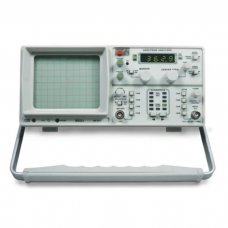Oscilloscope:
An oscilloscope is a device that allows you to see how voltage changes over time by displaying a waveform of electronic signals.
When you have circuits that have constant voltages a multimeter is a tool that can be used to measure a single number for the voltage. This becomes redundant when you start building more complex circuits. This is where an oscilloscope comes in handy.
An oscilloscope allows you to view how voltage changes over time. These voltages are called signals which are used to convey information such as an audio signal playing music on a loudspeaker.
Some of the things that the display screen on an oscilloscope shows is the measured signal of the voltage using a graph. The voltage is represented on the vertical axis and time on the horizontal axis.
This display will allow you to determine if the behavior of your circuits is working correctly. It will also allow you to locate any problems within your circuit like unwanted signals called noise.
There are two types of oscilloscope; analog and digital. More on that later, because now we will cover a brief history of the oscilloscope.
Signal Generator:
A signal generator is piece of test equipment that produces an electrical signal in the form of a wave. This is used as a stimulus for the item being tested.
Signal generators in all their forms are widely used within test and development systems, being used with other test instruments.
When looking at what a signal generator is, it will be seen that they come in many forms - there are many signal generator types, each one being used to provide a different form of signal. Some provide RF signals, others audio signals, some can provide different shapes of waveform and others may provide just pulses.
Logic Analyzer :
A logic analyzer is an electronic instrument that captures and displays multiple signals from a digital system or digital circuit. A logic analyzer may convert the captured data into timing diagrams, protocol decodes, state machine traces, assembly language, or may correlate assembly with source-level software. Logic analyzers have advanced triggering capabilities, and are useful when a user needs to see the timing relationships between many signals in a digital system.



